Pujita Guha reviews Oliver Ressler’s exhibition The Path is Never the Same, exploring the conflicts and confluences of activism, ecology and state repression.
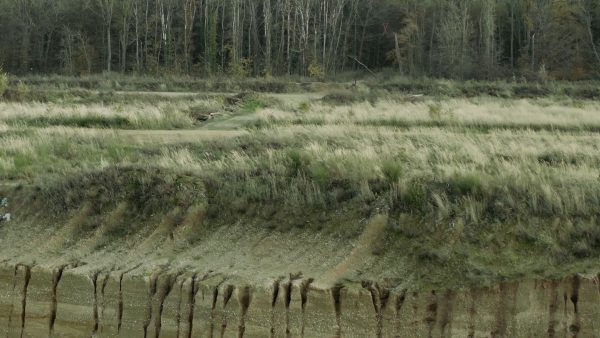
1. The scene of the crime
Exactly halfway through The Path is Never the Same, the viewer encounters a striated mound of soil and sand. Seen from a slight distance, the mound appears engulfed by silhouetted tall grasses, shrubs, with a thin bark curving up on the right edge of the frame. A narrow forested trail leads us to the mound, interjected almost rudely into our gaze toward the far horizon. Far in the background is the faint, blurred, barely distinguishable outline of an open-pit coal mine. What Oliver Ressler shows here is the “interfacing” between the drastically reduced Hambach forest in Germany’s North Rhine-Westphalia region and energy conglomerate RWE’s Tagebau Hambach lignite mine, which is gradually devouring the forest. The Hambach forest lies over lignite reserves, making it vulnerable to the mining industry. The Path is Never the Same dramatizes the resistance to RWE’s occupation and decimation of the forest, focusing on the counter-occupation by activists in small tree-houses. This dyad or interfacing between mine and forest gives the work its spatial contours. The activists demonstrate a deep elemental attunement to the forest. They learn to observe and read it, transforming their own way of life as they come to understand its light, rhythm, weather, humidity, rain, foliage and animal life. This attunement to the forest enfolds but far exceeds the acts of protesting and resistance to the state and mining company. Concerning attunement, more later.
The interfacing of the coal mine and the forest edge evokes historical “first contact” myths in which supposed civilizational “progress” encounters its “other”. The interface is not just a matter of edges and borders: the condition of the boundary is one of friction or agitation. Distinctions are made.1 The threshold between mine and forest is only 500 meters wide, or perhaps even non-existent: as the activists in the piece remind us, REW has already gnawed its way 30 meters into the forest. The frame appearing halfway through the film shows how close together these two worlds are in their constant friction, even as the distanced, observational camera work documents each realm separately. Early on in the film, Ressler juxtaposes close-ups of lush and verdant vegetal life – croaking frogs, glistening moss – with landscape shots of the vast bleak lignite mine whose symmetrical ridges are exposed on the earth’s surface. Monstrous serrated wheels dig into parched ground. Dark staircases down to the pit zig-zag across the landscape while the spoils of the mine – heaps of soil, sand and gravel – lie strewn among the mounds and hills above. The obscene matter of extractive capitalism is set against the abundant, life-affirming forest awaiting its death.
The obscene matter of extractive capitalism is set against the abundant, life-affirming forest awaiting its death.
The interfacing of the coal mine and the forest edge evokes historical “first contact” myths in which supposed civilizational “progress” encounters its “other”.
The mine is initially framed from within the forest, but the camera soon inverts its perspective, shifting to the striated landscapes of the mine before deftly raising the gaze back to the forest behind, in keeping with the film’s slow observational rhythm. The roving camera pauses only after allowing aerial view of the forest from over the canopies. In the far distance, two floating red bars cut across each other like an “X” that marks a spot. According to Anthony Vidler, the “X that marks the spot” is the “place of the body might be marked by tape and chalk on the ground to which it had fallen; the alleged site of the crime might be gridded with painstaking care in order to provide a coordinate system by which to situate the evidence, carefully collected in labeled bags for presentation in court; the tracks of the criminal, the traces of blood, the dispersed weapons, and their hastily jettisoned ammunition might all be gathered together and plotted on the special kind of map that criminologists have defined as appropriate to fix the “scene” of the crime in legally tenable terms.”2
The “X” marks not just the scene of the crime but also its attendant bureaucracies: the procedures and investigations that follow. It denotes that a crime has taken place, marking both the time and the site of investigation. In the Hambach forest, however, the red “X” is not a crime scene marker but a sign made by an activist, indicating the path to the nearest “barrio” (cluster of treehouses and barricades in the forest) and warning police and miners not to enter. Facing inward to the forest, the “X” marks a safe spot for the activists. Outwardly, to anyone seeing it from its interface, it cautions the intruder. It is a sign meant to stop the entry of the so-called civilizational worlds. Lying close to the interface, the “X” at this spot is not the marker of a crime that has already taken place but of one that is imminent: the murder of the forest by the mine. Thus the interface marks not just the site of difference but also the site of violence: the subsumption of all life into civilizational progress. The “X” marks the annihilation of the forest, and more fundamentally, it marks the negation of life and its abundant generosity. It is a murder whose exact time is unclear, yet palpable and imminent. As an unmistakable mark, it leaves no doubt about the forest’s future. It makes visible the threat at hand. By its very presence, the “X” demands an immediate reaction at the interface. It is both a “Stop” sign addressed to miners and state, and a call to action and resistance addressed to the activists. On a fundamental level, the “X” collapses the imminent future of the forest’s death into the local and immediate present – the urgency of action and resistance in the forest – by pre-empting the scene of the crime. 3
The “X” marks the annihilation of the forest, and more fundamentally, it marks the negation of life and its abundant generosity.
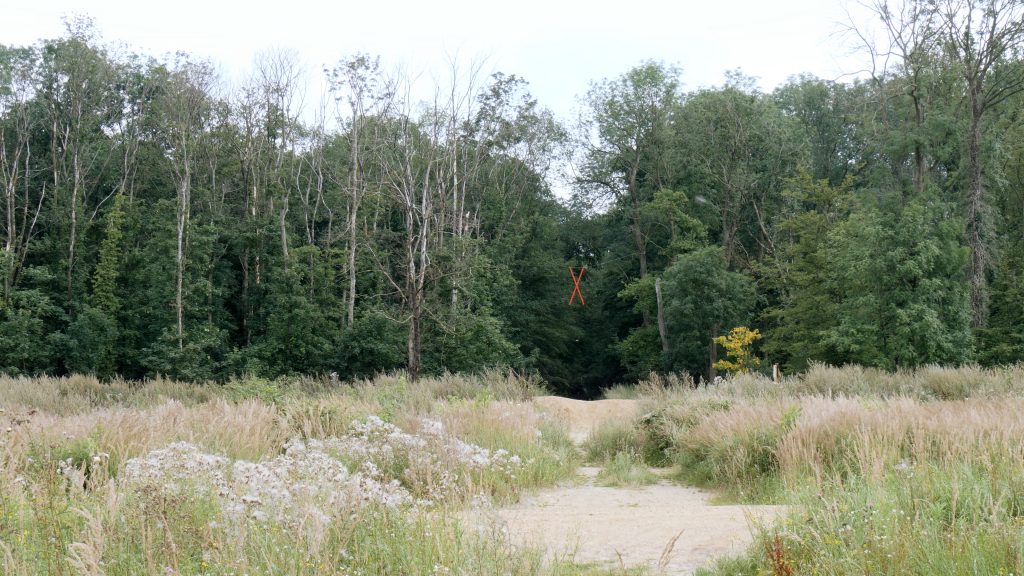




2. Occupying a canopy
Curiously enough, the red “X” is not on the ground. It is held together by cables that suspend it across the forest canopy. As a sign meant to stave off the enemy and to be read from a distance, it is hoisted and held at an altitude. The “X” marks the canopy itself as the scene of the crime, the scene of the death-to-be. A scene of death foretold which points to the life already existing in the forest. The Hambach forest canopy is revealed in the course of The Path Is Never The Same to be the film’s main protagonist. The film and the accompanying photographic series, How is the Air Up There, dwell on the canopy, the camera lingering on towering oaks whose interweaving crowns give the forest an architectural dimension. The viewer is drawn to the symmetrical trunks that soar to heights of 30 meters or more, where thinning branches seem to reach into the sky. Wherever foliage persists, weaved into the interlaced branches, light percolates in. A first glint from the corner scatters into the shade below. Technically a glint is the light facing the camera, the direct address or stare of the light itself. Yet here the glint flickers and disappears, a very particular “moment as a moment”.4 It disappears by the time the viewer is able to focus on it, leaving “conscious attention empty-handed.”5 The glint in the forest, then, points us to our own mechanisms of attention, of our desire to attune to light and its fleeting temporalities – and also perhaps to the wind, the rumble, and interwoven foliage swaying gently in the forest where the glint lives. But once again, concerning attunement, more later.
The glint and the shadows fall deep into the forest, but also onto the treehuts and the protest banners now occupying the Hambach canopy. The tree huts built by the activists over the years inhabit a symbolic space in the activist imaginary, peppering every piece of protest news or conversation, making the occupation of the forest visible. But these tree houses have often also been admired for their tactical subterfuge. The heights they are built at make the canopy a site of refuge when the police and the mining companies move into the forest to clear ground-level pathways and the bushes. Yet this flight or refuge is not absolute: in its impermanence it borders on anxiety. As the activists mention in the film, when the police move in to evict, they not only destroy their treehouses, they also violently fell the trees that held them. The treehouses, walkways, platforms and libraries are not just in the forest, on its ground, they are spread across its many branches, among the mosses, tips, leaves, trunks and vines of the canopy. The oak trees literally afford the treehouses and the activists an infrastructural hold, providing material support and a base for the emergence of activist forms of life.
As the camera looks at the treehouses from below and the wind shifts the glint, a protester’s voiceover narrates, bemused, “A lot of people ask – what it looks like here in winter – isn’t it cold?” The frame then cuts to another smaller tree house, set against an overcast gray sky, as the activist adds: “[there is] human warmth! I want to answer human warmth.” A seemingly innocuous answer about conviviality and communal life in the forest, sharing and huddling together in the library in the winters, becomes an exploration of the energy crisis at hand. The summers are made unbearable by the hot winds blowing over the mine into the forest. And the winters in the forest are uncomfortable too, without heating or energy consumption. The invention and progress of modern western life is predicated not just on the extraction and use of energy from earth (i.e. fossil fuels), but also on social control to regulate ambient temperatures and thereby to increase capacity for work, preservation, and comfort.6 Comfort, then, is the making and standardization of an “ideal” temperature and a set of desires (for work, sleep, etc.) defined by a lack of thermal sensation: ideal comfort occurs when any sensation of heat, humidity or cold withers away from active perception.7 The film and the activists in it ask: what happens when this comfort is taken away? Confronted by the heat of the mines while refusing subsumption into the energy-guzzling world of architectural heating, the protestors must consider how to live ethically in a forest that interfaces with an open lignite mine nearby.
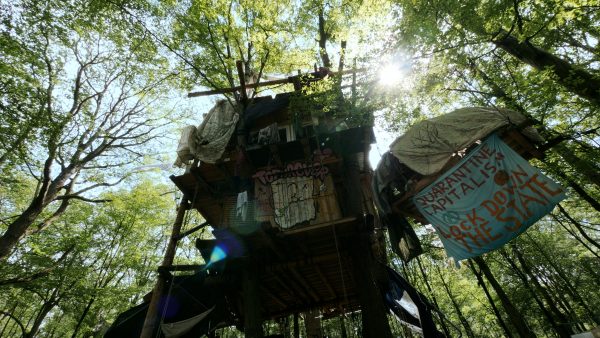
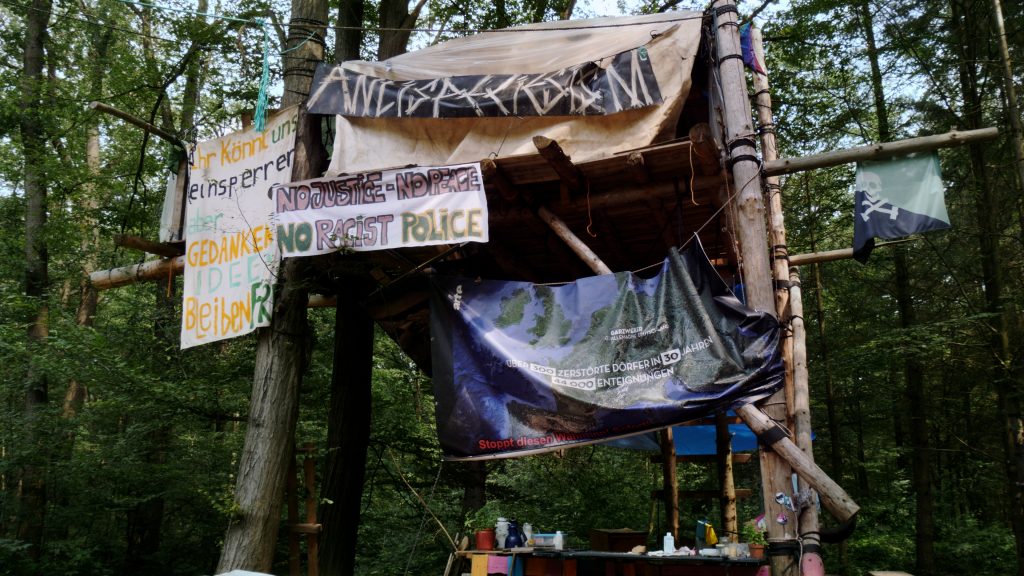

3. Swiveling in the branches
The activists speaking in the film quip breathlessly that comfort for them lies in the ability to wake up and notice the squirrels by their window, or to find your tree house moved along with the wind, or even to take a wooden panel down if you want the wind to sweep the dust on the floors away. This lighthearted take on the little joys of the forest becomes a larger conversation on what comfort could mean here. For the activists, it is no longer a matter of heat and sensation, but of attunement: the training and retraining of lived, bodily habits to recognize other non-extractive lifeworlds and their making. Attunement means noticing the details of previously unexperienced sensory lifeworlds in a specific milieu. Attunement is the “cultivation of subtler sensitivities,”8 “the training and expanding of one’s sensate regimes to environmental events and densities that may fall off our attention and perceptual regimes.”9 For the activists, then, comfort is a process of attuning with the minutiae of the forest. The joy that the forest offers is that of playful engagement in these “arts of noticing”: the ability or intention to notice squirrels and the changing foliage on the canopied pathways; the process of learning to balance and move adroitly on the canopies, or to wait for the wind to help you in house cleaning chores; learning to balance in the tree house as it swings like a boat.
But attunement is more than the training of sensory perception, it also means learning to navigate and inhabit a milieu. In the shot where one activist speaks of summer winds blowing from the mine into the forest, the camera steadily focuses onto another activist making their way through the canopy. Looping a rope across a branch, the activist first plants their left foot on a bigger branch, pulling themselves up. Then they swiftly swivel around, holding onto a thinner branch above them, bending their knees, staying closer to the branch as they climb higher. Carefully, they curve their feet around the branches to grasp them, taking one step at a time as the branch scythes diagonally across the canopy (and the frame). The branches and the oak leaves move, hiding the activist from our view. Only the rope attached to the harness and the deftness of the whole procedure remain visible. I describe this shot and the activist’s movements in such detail because it brings out what living in the canopy actually entails and the kind of attunement it truly demands: a necessary reorientation of human movement through a space. The modern history of Europe has been deeply invested in shaping homo erectus as a cultural (as much as an archaeological) phenomenon. 10 Homo erectus (upright man) is an extinct hominid species whose distinctive feature was bipedalism – the ability to stand straight on stable ground, rolling from heel to toe while striding forward, even when landing flat-footed with a thud. Walking as an embodied condition. This bipedalism depended on stable ground: an even surface on which the walker could remain erect while subject to gravity. But what happens when we no longer have access to the ground? In her work on oceanic phenomenology, Melody Jue cites oceanic deep diving as a mode of attunement distinct from the conditions of life on land, one that involves learning how to move horizontally and stay afloat, learning to dive and bear oceanic pressure, learning to regulate breathing patterns with diving equipment and an oxygen cylinder. 11 Being in the ocean also means giving up on land-bound ways of sensing the world. In the oceanic column, perception is altered by the drift of underlit waters, the sensation of floating, and the opacity of the water itself. A world of difference from the stable, upright images produced by the camera on the ground. 12
How then, we might ask, does one attune to the canopy? What does it demand that is phenomenologically specific? The canopy is both on land and at a distance from it. The stable, even ground gives way to unevenly growing branches and leaves, some thinning or dead, unable to bear weight. How is the world seen from the canopy while moving around in it? To clarify, the reference here is neither to an image of the canopy from above (as in an aerial shot with a hovering effect), nor to that from the firm ground below (a stable upward view of the crowns of oak). Nor is it a question of using the visual technology offered by forestry. While contemporary forest ecology as a discipline depends on massive-scale digital sensing and satellite/LIDAR imaging, its practitioners still work from air balloons with drop-down rafts that place field ecologists in the canopy as they observe the region, or from canopy cranes equipped with a rotating boom and arm to place a platform at the desired location or height. 13 These methods provide easy access to the canopy, but observation via roving a craft or the crane-platform combination mimics the stability of the view from the ground. The observational platforms allow the scientist to maintain the standpoint of homo erectus, observing the canopy as a straight, walking, vertical figure, able to enter and exit at will as an upright man. But this elides what it means to be in the canopy and to sense from within it. What do we perform with its branches and twigs? Ressler offers a brief glimpse of an answer by showing us the camera tied to the activist who moves across the canopy. The resulting image appears destabilized, oscillating unnervingly with the activist’s movement along the branch. More importantly, the viewer’s imagination of the canopy comes undone. It no longer appears as the stable crowns seen from above or below: rather, the branches protrude like distended arms. Distances are confounded as perspective is broken up by various leaves gently swinging, tending towards noise: an indistinct mass of greenery. To be immersed in the canopy is to lose the sense of the ground, which is unevenly present at most, peeking through at certain spots. As the camera moves through the canopy, the viewer loses all orientation to height and depth. In this state of immersion, the standpoint is lost to noisy engulfment in leaves and epiphytic growth. Orientation returns only briefly when the activist’s feet appear between two branches, along with the harness and rope.
The activist’s movement around the canopy reveals not just a distinct visual experience, but also a singular kinesthetics and sensory attunement. Moving through the canopy is not just a steady vertical ascent as in tree-climbing, it is more like clambering transversely among a network of small branches. It involves learning how to bend and swirl, to curve toes to grasp branches, or even to hang from and leap between branches using all the body’s limbs at once. It can also require learning how to bend elbows and joints inward (to supinate), and to position personal body weight to avoid losing balance and falling the branches. Yet these techniques do not entail a return to “primitive” living or any mimicry of tree-dwelling primates’ quadrupedalism: they make up a tactical lifeworld, attuned reasonably to what is possible within bipedalism while renouncing the claims of homo erectus. Nor are the stakes here solely physiological. To give up homo erectus is also to give up the civilizational command laid claim to by the perfectly upright human figure, the dominant speciesist model of “stiffness and radical rectitude for any military drill”. 14 Western modernity has historically projected “more and more noble or correct regularity” onto the human anatomical form, the epitome being that of a soldier, ready to carry out any order on command. Perhaps then, for an anarchist life in the canopy, resisting the militarization of the state comes at the cost of giving up bipedalism and the related aspirations of control in favor of a tactical life in the canopy in makeshift, rickety tree houses and the forms of comfort and attunement this demands. It means clambering in the canopy, slinging a rope and moving around the branches attached to a harness. It is attunement, and it resists the bodily rectitude, the stiffness of the back that comes with the police state.
The activists also extend this attunement to the canopy (and the forest at large) to their prefigurative political organizing, which is attuned in turn to the networked, non-hierarchical nature of the forest, attuned temporally to its imperceptible rhythms of growth, decay and renewal. As the film winds down, an activist remarks that organizing in the forest may appear disorderly and chaotic. No two people take the same route to a meeting point, everyone is scattered and arrives at the meeting late. It could be said jokingly that the path is quite literally never the same in the forest. But perhaps it is this scattering that makes it possible to live and walk in unseen, unheard, and unperceived ways, even clambering through the canopy.

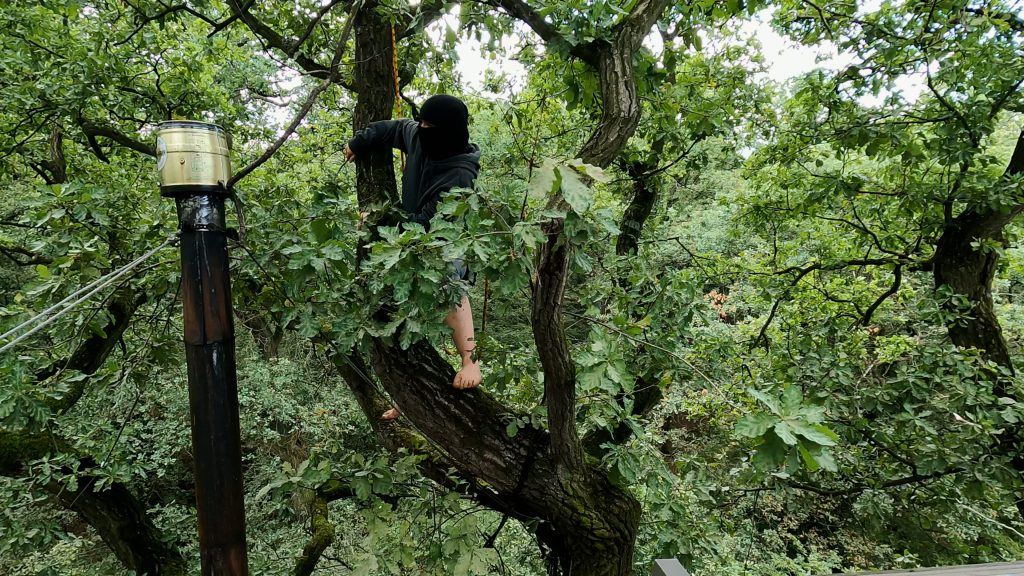

Pujita Guha is an artist, curator, and PhD candidate at the Film and Media Studies Department at University of California, Santa Barbara. Her interests move between forested histories in upland south and southeast Asia, indigenous politics, and environmental media.
Acknowledgement: Much gratitude to Sudipto Basu, Dolly Guha, and Zach McLane for their comments and feedback on this piece.
1 Alexander R. Galloway, The Interface Effect, Cambridge: Polity, 2012, p. 31.
2 Anthony Vidler, Warped Space: Art, Architecture, and Anxiety in Modern Culture,Cambridge: MIT Press, 2000, p. 123.
3 Colin Milburn and Rita Raley, “Red Dot Sight,” in: The Routledge Companion to Media and Risk,ed. Bhaskar Sarkar and Bishnupriya Ghosh, New York: Routledge Taylor and Francis, 2021, p. 278.
4 Hank Gerba, “The Glint,” in: Real Life Mag,February 11, 2021, www.reallifemag.com/the-glint/ [accessed March 23, 2023].
5 Ibid.
6 Nicole Starosielski, Media Hot and Cold, Durham: Duke University Press, 2021, p. 14.
7 Ibid, p. 34.
8 Natasha Myers, “Becoming Sensor in Sentient Worlds: A More-than-natural History of a Black Oak Savannah,” in: Between Matter and Method: Encounters Between Anthropology and Art,ed. Gretchen Bakke and Marina Peterson, London: Bloomsbury Academic Press, 2018, p. 76.
9 Pujita Guha, “Seeding the Forest,” in: Cultural Politics,vol. 19, 2023.
10 Adam Arsdale, “Homo erectus: A Bigger, Smarter, Faster Hominin Lineage,” in: Nature Education Knowledge, vol. 4, no. 1(2), 2013.www.nature.com/scitable/knowledge/library/homo-erectus-a-bigger-smarter-97879043/ [accessed March 23, 2023].
11 Melody Jue, Wild Blue Media: Thinking Through the Seawater, Durham: Duke University Press 2020, pp. 6–8.
12 Ibid, pp. 150–151.
13 Margaret Moffett and M.D. Lowman, “Canopy access techniques,” in: Forest Canopies, ed. M. D. Lowman and N. M. Nadkarni, New York: Academic Press, 1995, pp. 12–15; Roman Dial, Stephen C. Sillett, and Jim C. Spickler, “‘Canopy Trekking’: A Ground-Independent, Rope-Based Method for Horizontal Movement through Forest Canopies,” in: Forest Canopies, ed. Margaret Lowman and H. Bruce Linker, London: Elsevier, 2004, pp. 63–64.
14 Georges Bataille, “The Jesuve,” in: Visions of Excess: Selected Writings 1927–1939,edited and with an introduction by Allen Stoekl, Minneapolis: University of Minnesota Press, 2008, p. 76.